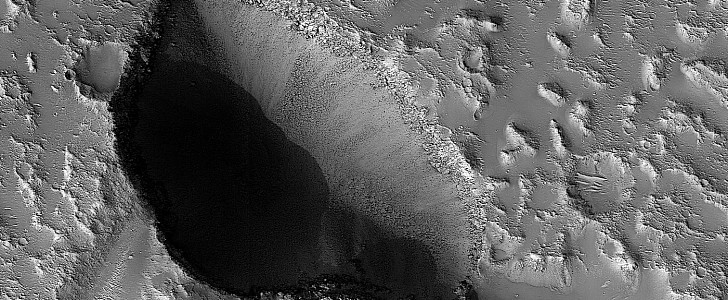If you’re even remotely interested in the study of Mars, then you’re used to seeing images of the many impact craters scattered all across its surface. But for what it’s worth, craters are not the only scars that dig deep into the Martian soil.
Although now it may not look like it, with only quakes and severe dust storms disturbing the peace, Mars was once a very active place. At some point, it even had water, and so much of it, in fact, that catastrophic floods were not only possible, but also quite common, when the conditions were right.
One place where such things occurred was the Hebrus Valles, west of the Elysium volcanic region. It’s an area riddled with Individual troughs. Their exact origins are not entirely explained, but the most likely cause for their apparition was floods.
These channels are generally very wide, reaching several miles in some places. In Hebrus, they seem to come to an abrupt end in the pit you see before your eyes, snapped from 286 km (178 miles) in orbit by the HiRISE camera.
Taken back in 2016 and only recently made public by NASA and the University of Arizona, the image reveals the hole in the ground, of which, thanks to complicated math that took into account even the shadows that fall upon it, we now know it’s massive.
Scientists say the place is 1,875 meters long and 1,125 meters wide (6,151 feet long and 3.690 feet wide), and taking into account the way the shadow fell on it at the time the pic was snapped, may be as deep as 500 meters (1,640 feet).
The pit, which was formed through an unexplained process after the channels came to be, could turn out to be essential for future crewed missions to Mars, and even for potential settlements there. Scientists speculate such pits could be filled with subsurface ice, and from that, the element that keeps us all alive, water, could of course be extracted.
One place where such things occurred was the Hebrus Valles, west of the Elysium volcanic region. It’s an area riddled with Individual troughs. Their exact origins are not entirely explained, but the most likely cause for their apparition was floods.
These channels are generally very wide, reaching several miles in some places. In Hebrus, they seem to come to an abrupt end in the pit you see before your eyes, snapped from 286 km (178 miles) in orbit by the HiRISE camera.
Taken back in 2016 and only recently made public by NASA and the University of Arizona, the image reveals the hole in the ground, of which, thanks to complicated math that took into account even the shadows that fall upon it, we now know it’s massive.
Scientists say the place is 1,875 meters long and 1,125 meters wide (6,151 feet long and 3.690 feet wide), and taking into account the way the shadow fell on it at the time the pic was snapped, may be as deep as 500 meters (1,640 feet).
The pit, which was formed through an unexplained process after the channels came to be, could turn out to be essential for future crewed missions to Mars, and even for potential settlements there. Scientists speculate such pits could be filled with subsurface ice, and from that, the element that keeps us all alive, water, could of course be extracted.






